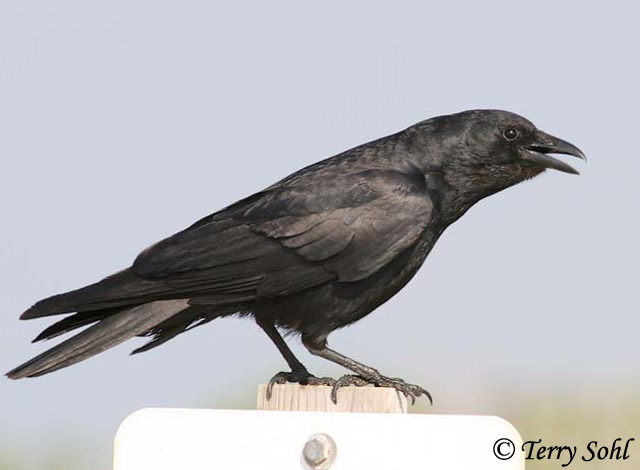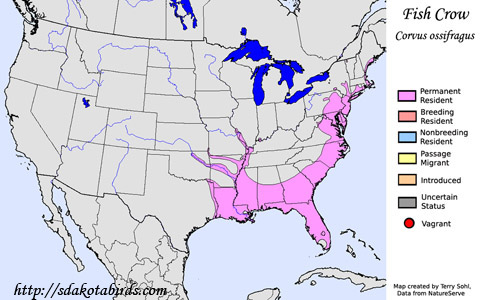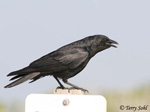| Length: 15 inches | Wingspan: 16 inches | Seasonality: Non-resident in South Dakota |
| ID Keys: Black plumage. Compared to American Crow, smaller, with longer tail and wings, and shorter legs. | ||
 The
Fish Crow is very similar to the more widespread
American Crow. However, while the
American Crow is found throughout much of North America, the Fish Crow's
range is restricted to the southeastern United States, where they are most
often found along the coast or near large river systems. They can be
extremely difficult to differentiate from the American Crow, although they
are slightly smaller, and have other minor structural differences. The
safest way to tell the two species apart is by voice.
The
Fish Crow is very similar to the more widespread
American Crow. However, while the
American Crow is found throughout much of North America, the Fish Crow's
range is restricted to the southeastern United States, where they are most
often found along the coast or near large river systems. They can be
extremely difficult to differentiate from the American Crow, although they
are slightly smaller, and have other minor structural differences. The
safest way to tell the two species apart is by voice.
Habitat: Found in a variety of habitats, but tends to be found around water. They are most often found along the coast and surrounding habitats, but can also be found inland near large river systems.
Diet: Omnivorous. Diet depends upon location and seasonality, but may include insects, crustaceans, mollusks, bird eggs, reptile eggs, small vertebrates, carrion, refuse, fruits, nuts, and berries.
Behavior: Foraging technique depends on the food item, but they most often foraging by walking along the ground.
Nesting: The nest of a Fish Crow is a large platform of sticks and pieces of bark, lined with softer materials that may include grasses, weed stems, rootlets, feathers, pine needles, or even refuse. The female lays 4 or 5 eggs, and she likely does most of the incubation. When the eggs hatch, both parents help feed the young and tend to them.
Song: Most often gives a simple, nasal caw call. Also has other hoarse croaking and rattling calls.
Migration: Considered a permanent resident throughout its normal range. Birds found inland, however, may move more towards the coast for the winter.
Interactive eBird Map: Click here to access an interactive eBird map of Fish Crow sightings
Similar Species: Very similar to American Crow. They are slightly smaller than the American Crow, with longer wings, a longer tail, and shorter legs. However, they are usually only safely told apart from the American Crow by voice.
Conservation Status: Populations are large, they are spread over a wide geographic region, and they appear to be increasing. The IUCN lists the Fish Crow as a species of "Least Concern".
Further Information: 1) BirdLife International - Fish Crow
2) WhatBird - Fish Crow
3) Audubon Guide - Fish Crow
Photo Information: Photo taken on June 23rd, 2005 - Assateague Island in Virginia - Terry Sohl
| Click below for a higher-resolution map |
 |
| South Dakota Status: Non-resident in South Dakota |
Additional Fish Crow Photos
Click for a higher-resolution version of these photos

